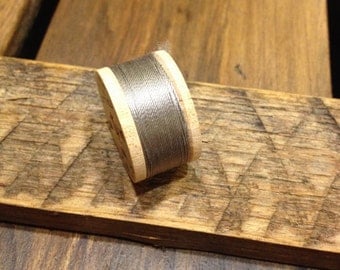See that skin peeking out? You can also see the top trying to make a bit of a dart, extending out, and hanging straight down from my boobs. Do you see my flesh at the side slit? I brought that slit down an inch or so. It is what it is. I have a white chiffon cami I will wear with this next time. Don't get me wrong. I still really like the top. What get's me is that I didn't follow my own often spoken advice to really read the pattern photo on the cover. Guilty. I'm not sure I would recommend this pattern for a newer sewist. The directions are excellent, very clear, nothing missing. It is a bit challenging on the step where the hidden placket meets the hem band but it is all laid out. The good thing is MimiG has a youtube video sew along and you can follow the entire construction if you like.
Fit:
I flat pattern measured and actually decided not to petite the upper chest of this pattern. It worked out fine.
* I did an FBA adding 1 1/4 inches to the bust. I take a C cup.
* I shortened the back length by 2 inches. Why? The hem it came with would have put the hem edge right at a full part of my hips and shortened my "leg look length". By raising it, it ends up in a more flattering spot for me. Five footers fight for all the leg length they can get! It is still very hi-lo.
Remember, if you shorten the length of the top, do it in the area above the hem band and below the armscye.
* The last fit issue I dealt with was adding more room in the hips. I found I wanted just a bit more ease in the back so the easiest way was to just make the pleat deeper. I added one inch to the depth of the back pleat and to the hem band in back at the same spot.
Construction:
This is a pattern where you really need to follow the directions. There were 26 steps. I liked the challenge of all the detail. I chose to topstitch most edges with the heinous "stretch stitch" , aka, triple stitch. It is great for topstitching, giving a thicker look to this seam finish. For the less experienced sewist, the curved hem band meetings at side seam can get a bit futzy and there is always the fun of a traditional collar with stand in this pattern as well. That is the one place I veered from the pattern and did the Nancy Zieman method which you can find in my tutorials. It gave a nice crisp finish as it always does.
Once again I did my buttonholes without a buttonhole foot and they came out beautifully, except for the one on the collar stand. That part of the stand is on the bias. That and the stretch spandex insisted on a wavy BH. I ironed it away but it was definitely not as nice as the ones hiding in the placket. I would use a lighter interfacing or just behind the BHs, next time I do a hidden placket like this. I cut down the pocket a 1/4 inch all around, the petite scaling thing. I didn't do the collar as I liked it as it was. The construction went smoothly, just following directions. They were well written.
The Pants
Fabric:
The pants fabric is Telio Kahlo slub rayon in "seaweed" coloration. I was inspired by a pair of loose, cropped pants I saw Linda Lee wear on a video. Matching this print was a near impossibility. It would have worked just fine if I went the no match route. but my inspiration pant had a soft large print match around the knees and I wanted that. I found in this fabric a couple of large motifs matched but there were tons of random splotches that defied any sort of repeat. I went with the large motif I wanted to match and didn't worry about anything else. Results below.
This fabric, 100% rayon, is quite lightweight, I believe in the low 4 ounce range. It is near sheer. Lee suggested lining these near sheer rayons with polyester mesh. I'd never heard of such but gave it a try. It worked out great and I will do that again. The lining is a relatively heavy fabric so hangs nicely, doesn't ride or stick to anything and does it's lining job well. There is a lot more information on the fabrics I used HERE.
Pattern:
For the pants I used my Sure Fit pants sloper to start. I did a simple gathered waist and cropped leg with a 1 1/4 inch deep machine hem, no pockets. I rarely do pockets in pants as they add bulk and width to my already wide hips. I love this style and it's soft folds on the hips and legs help even out my proportions. I do think a short top makes it work.
Construction:
These pants were very very easy to construct. They were classic drop one leg into the other pants sewing. I have seen people on youtube making pants in such difficult other ways. Most patterns tell you to do the leg in leg method. It is so fast and easy. I don't get it. Oh, well, to each his own.
For these pants the toughest part was establishing the print layout. Once I had that done it was pretty easy. I made the lining in the exact same method. I dropped the lining into the pant and basted them together at the waistline, not the seam. I attached non roll waist elastic, cut 2 inches smaller than my waist, to the top edge of the pant with a triple zigzag stitch. I turned it to the inside,covering up the top raw edge of the lining. I stitched the bottom edge again with a triple zigzag. Done and so easy.
The hem was serged , then folded to the inside 1 1/4 inches and stitched down at the top edge. I liked this deeper hem on such thin fabric. The extra weight of a deeper hem helps it hang better. Oh, I let this rayon hang out for several days before hemming. The mesh lining was simply cut with a rotary cutter about an inch and a half shorter.
I love this outfit. I like MimiG's pattern and it's clear directions. While I wouldn't recommend this normally for a newbie sewist, if they want to sew along with MimiG's video on youtube, I think they can pull this off. I'm not crazy about my top fabric of these coordinates but I do have a lovely and short sleeveless top in olive green linen that I made a couple years back. It goes really well with these pants. I think I will get a lot of wear out of them. I liked this fabric so much that I went right out and bought another few yards of a different print but still Telio Kahlo slub rayon. it will become a tunic. I recommend this pattern with the caveat about the fit of the bustline that happens to box type tops. I will live with it and wear a cami underneath.
****************************************************************************
My husband and I have been devoting nearly every spare minute lately to painting our home. I'll post before and afters when we are done. This is a 1962 ranch house that was painted mint green with maroon trim. I can honestly say I lived in a very ugly house. You can see we've gone whole different route. We love how darker homes look in wooded settings and it worked out well here. This cedar sunburst was black with mold and had never been cleaned or treated since the day it went up. My husband got off all the years of crud and will be sealing it tomorrow.That will bring out the beautiful cedar even more. My job will be painting the last side of the house on the left, yay! Almost done!........Bunny



























